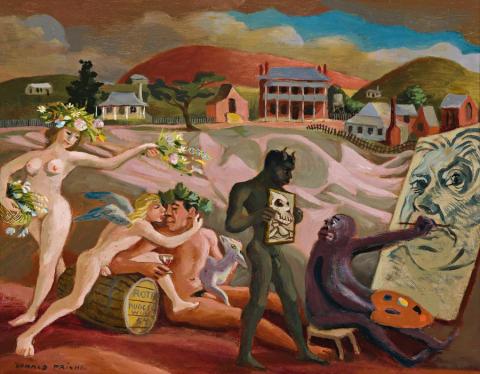GODS VISIT THE SELF PORTRAITIST (FLORA, AMOR, BACCHUS AND FAUN) 1954, c.1970-75
DONALD FRIEND
oil on canvas-board
35.5 x 45.5 cm
signed lower left: DONALD FRIEND
inscribed on label verso: Gods visit the self portraitist./ ((Flora, Amore, Bacchus & Faun)) / Donald Friend, / for Attilio. / (Note: The Talented Ape is / left handed. The background / shows my old cottage & the Royal Hotel / etc at Hill End, in N.S.W.)
Donald Friend's oeuvre is rich in subject pictures - allegorical, historical, witty and satirical, often pulsating with a Hogarthian rumbustiousness. In Australian legend viewed from a contemporary standpoint, none has quite the humour and bite of The Apotheosis of Ned Kelly, 1946 - of Ned Kelly received into Heaven by ratbags, a general, a bishop and a bull. All is covered by the protective wings of the white dove of peace - carrying in its claws an atomic bomb. For St Patrick's Night, Sally's Flat, 1948, the boisterous scene of revelry recalls a watercolour or two of S.T. Gill's lively scenes of life on the goldfields. And again in 1948, for Love Me Sailor, 1948, Friend turned to Hieronymus Bosch to inspire his painting with fantastic creatures who could have wandered out of his triptych, The Garden of Earthly Delights, c1504. They are presided over by a judge, a scarlet-robed frog as self-important as Toad of Toad Hall. The satirical impulse was never far away in Friend's art, extroverted and often boisterous, full of figures, beer and wine.
Of the Hill End allegorical fantasies, Gods Visit the Self Portraitist (Flora, Amor, Bacchus and Faun) 1954, c1970-75, digs deeper into the personal side. Set within the Hill End landscape, it brings together many of those pleasures of life that appealed to Friend, raising his Antipodean Garden of Eden to Elysian heights. The visiting deities are from the Roman pantheon - Flora, goddess of flowers and gardens, who also had connections with a celebrated Roman courtesan by that name; Amor, the son of Venus, was god of love; and Bacchus god of wine and related good times. The festivals of Bacchus were, of course, usually called Orgies or Bacchanals. In our painting, the wine barrel advertises its contents as'Mudgee Wine', a glass of which is enjoyed by the very god himself. As the garlanded Flora spreads floral beauty as if from a painting by Botticelli, the winged and fair-haired Amor reaches across the barrel to kiss the figure of Bacchus, identified as Friend's one-time young Italian lover, Attilio Guarracino. Friend had met Guarracino, the son of an Ischian fisherman, in 1950. Returning to Hill End in September, their volatile relationship foundered after a few months and Guarracino left.1 To the right of the composition, Friend gives the dark figured Faun the mirror to hold so that he, the simian self portraitist can capture the illusion of reality on the painted canvas.2 The skull reflected in the mirror (truth and mortality) is translated into the outer appearance, the persona, the mask, the self portrait being an act of self revelation. As ever, Friend's images are painted in colours of ravishing beauty.
1. Bacchus/Guarracino holds a goat under his left arm. As the goat was the animal usually sacrificed to Bacchus, one can only guess at what Friend had in mind.
2. The Faun is a rural deity, usually presented as human figured with a goat's horns, legs and tail, identified with the Greek god Pan, given to terrifying the local inhabitants and providing us with the word 'panic'.
DAVID THOMAS
